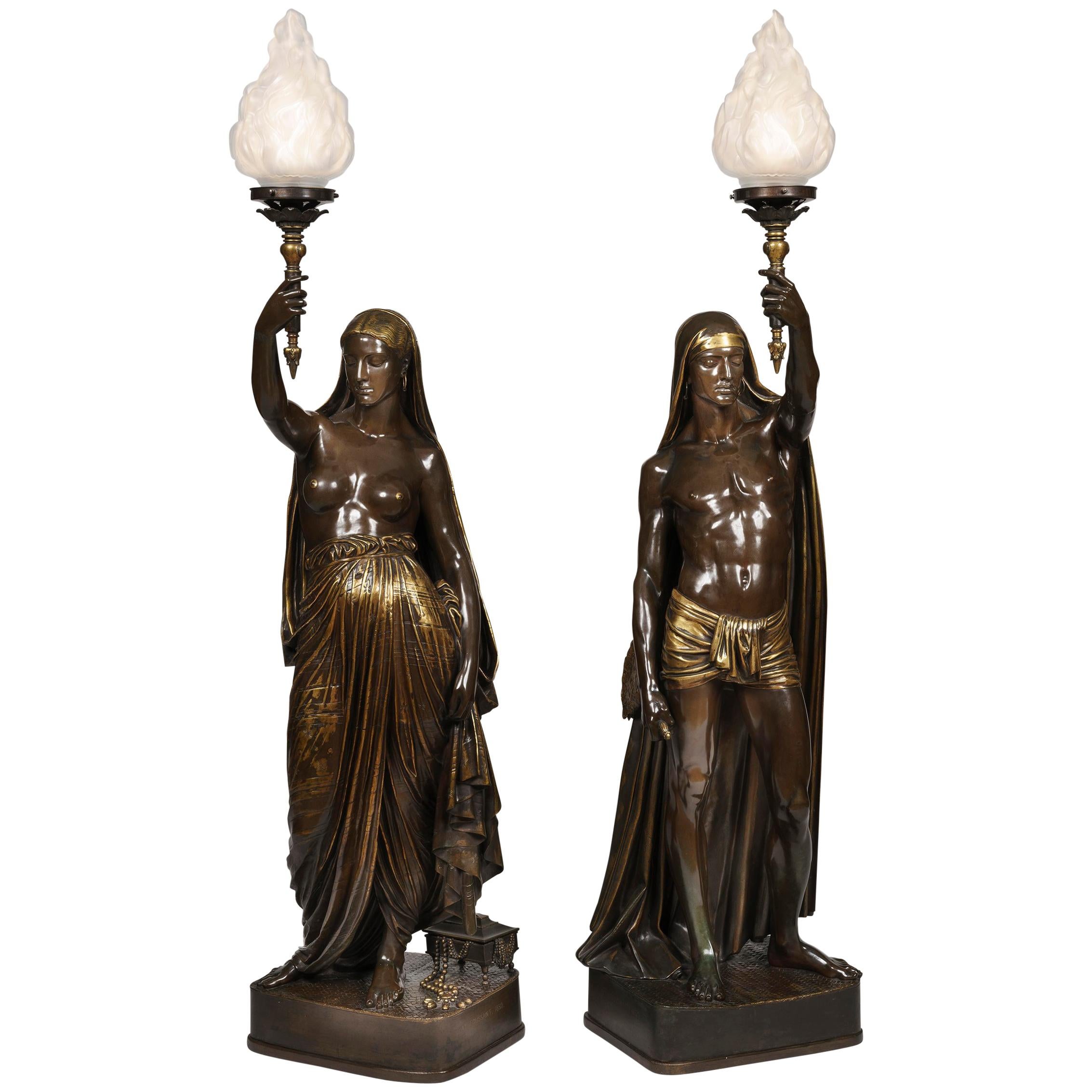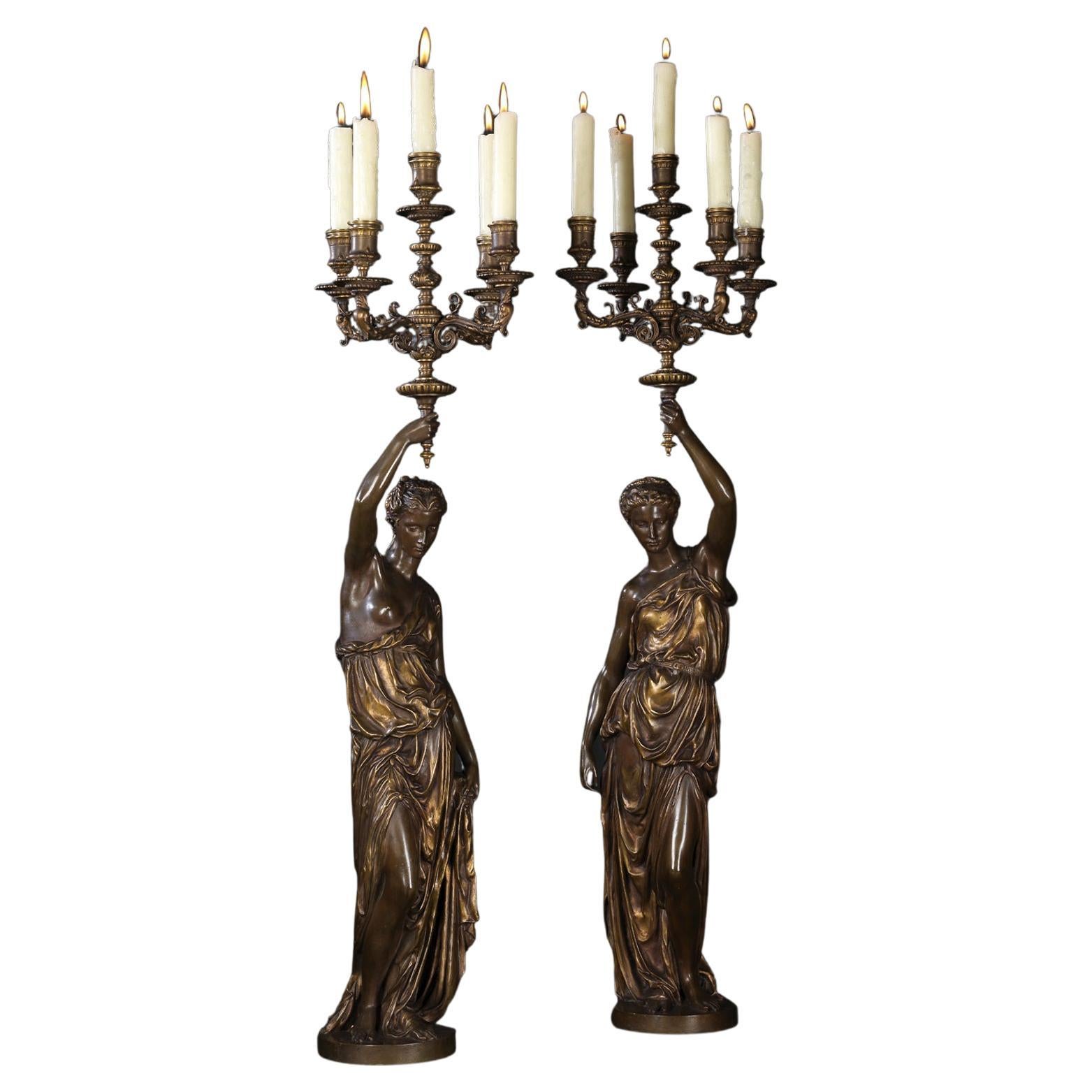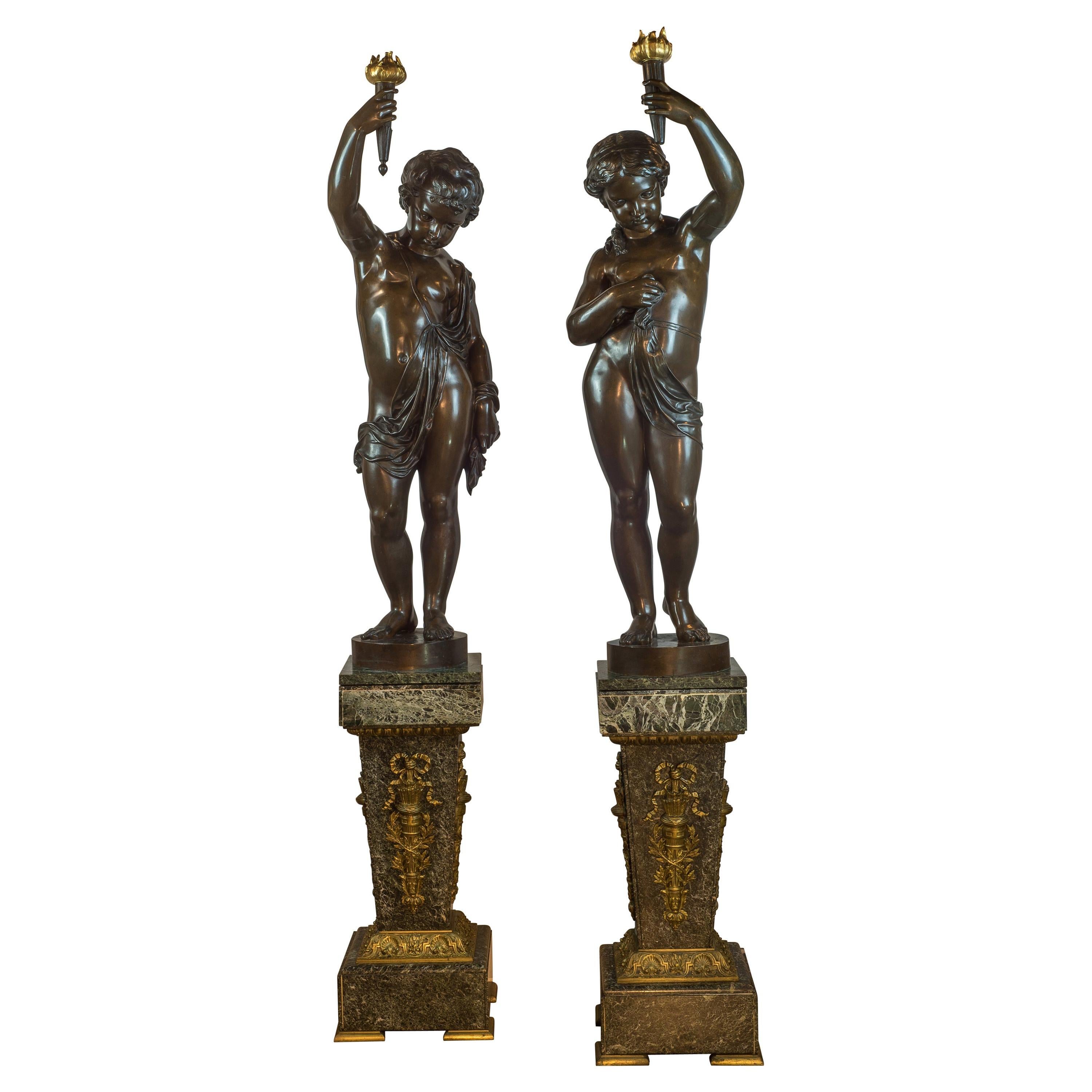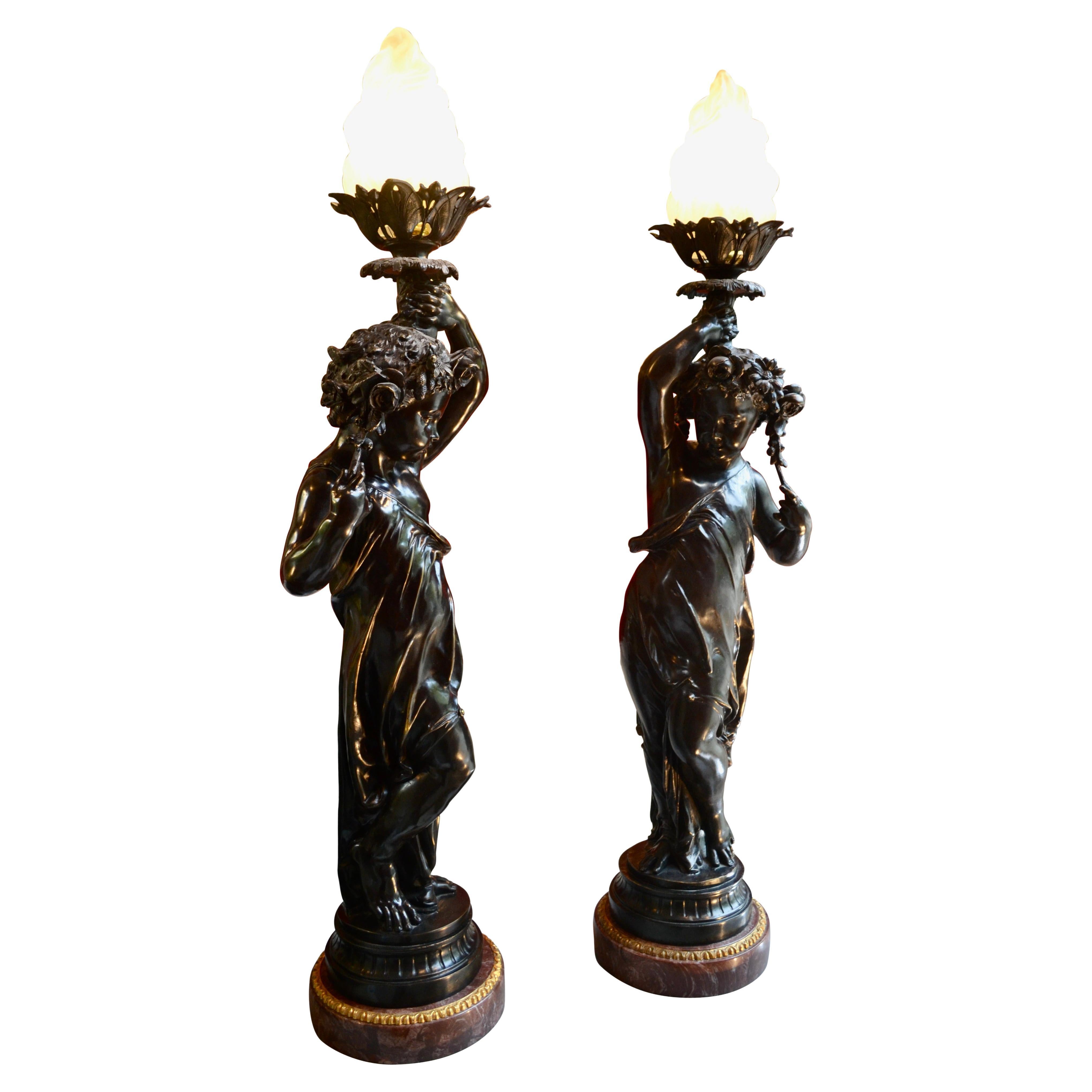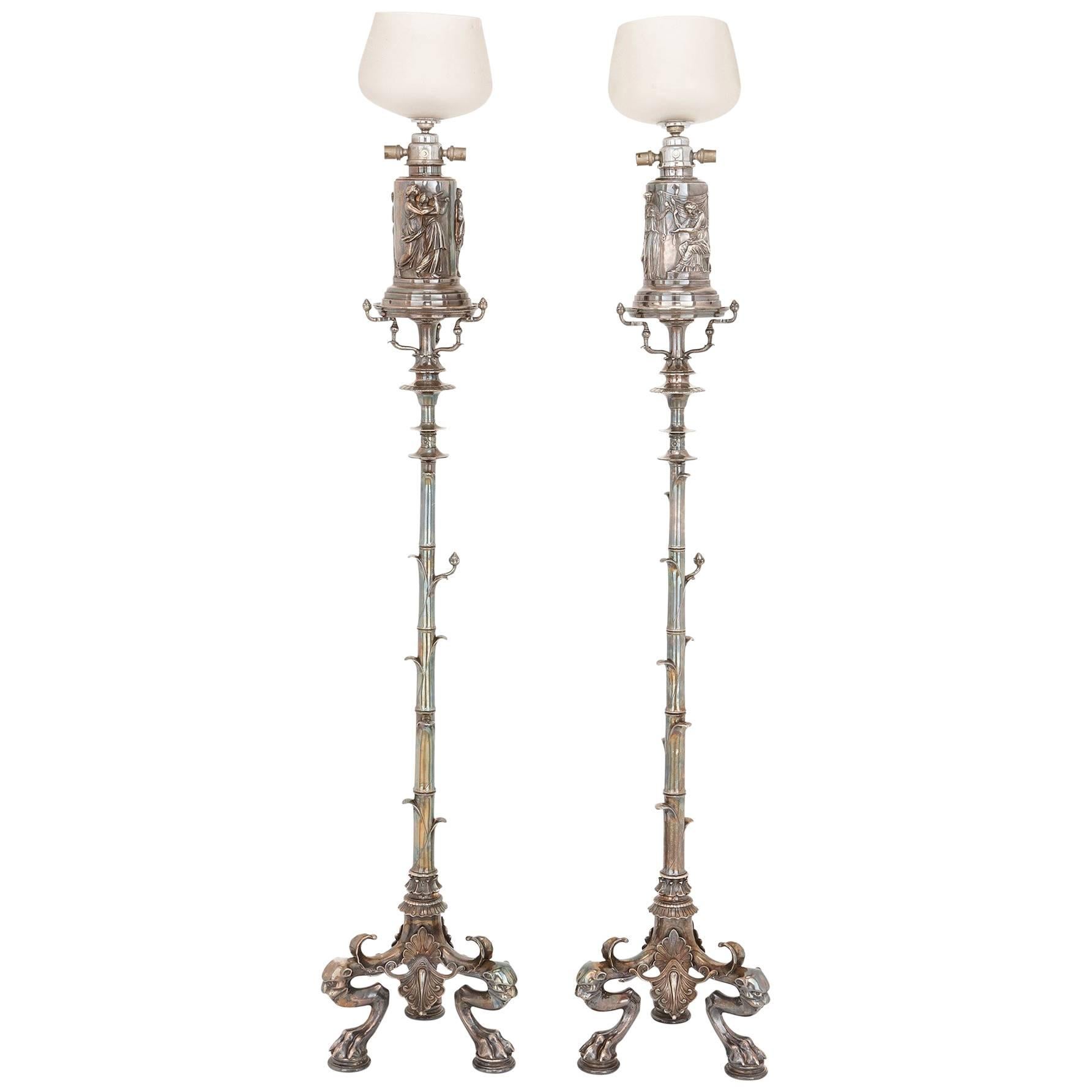Items Similar to Pair of Large Patinated Bronze Figural Torcheres Cast by Barbedienne, Dated 1872
Want more images or videos?
Request additional images or videos from the seller
1 of 12
Pair of Large Patinated Bronze Figural Torcheres Cast by Barbedienne, Dated 1872
About the Item
A highly important pair of large patinated bronze figural torcheres by Émile Guillemin, cast by Ferdinand Barbedienne.
French, dated 1872.
Barbedienne Title: 'Deux Femmes, Indienne et Persane'.
Incised 'Ele. Guillemin 1872' and bearing the cachet for 'F. BARBEDIENNE FONDEUR'.
This grand and imposing pair of figural torcheres are of exceptional quality, the figures finely cast with wonderful detail and finely patinated. Barbedienne made a number of editions of this model in different sizes, the present examples being the largest and rarest. The models are listed in Ferdinand Barbedienne's 1886 catalogue as Deux Femmes, Indienne et Persane.
Ferdinand Barbedienne (1810-1892) was the inspiration and driving force behind one of the most important French art foundries. He pioneered the use of mounts and, more commonly, bronze sculpture including figures and animals. Barbedienne produced catalogues of bronze reproductions of Greek and Roman classical sculpture and experimented with champlevé and cloisonné enamels during the third quarter of the century. Barbedienne exhibited several pieces of furniture at the 1855 Paris Exhibition including an ormolu mounted oak dressing table and an ormolu mounted ebony veneered bookcase. Both pieces were executed in his favoured Renaissance revival style for furniture. Furniture with mounts signed by Barbedienne is extremely rare.
The Barbedienne foundry handled the casting of numerous national monuments and architectural schemes. Ferdinand Barbedienne himself also took an active part in the promotion of contemporary sculpture and became one of the founders for David d'Angers' medallions as well as much of Rude's sculpture.
His signature varied from hand written capitals to stamp in capitals, usually 'F. Barbedienne, Fondeur' or 'BARBEDIENNE PARIS'.
In 1839 Barbedienne collaborated with the inventor Achille Collas who had succeeded in enlarging and reducing works of art to arbitrary sizes by a simple mathematical calculation, allowing the accurate reduction of classical and contemporary marbles for the purpose of reproduction in bronze. In 1850 Barbedienne was commissioned to furnish the Paris town hall for which he was awarded with the médaille d'honneur at the Paris Exposition Universelle in 1855.
Bibliography:
Barbedienne, Ferdinand. Catalogue des Bronzes d'art 1886.
Fonderie d'art Français: Val d'Osne, Fonderie de Tusey, Antoine-Louis Barye, Fonderie Rudier, Charles Crozatier, Ferdinand Barbedienne' Livres Groupe, (Paris), 2010.
Émile-Coriolan-Hippolyte Guillemin (1841- 1907) was born in Paris, he studied under his father, the painter Émile-Marie Guillemin, and was also a pupil of Salmson.
He made his debut at the Salon in 1870 with a pair of Roman gladiators, later winning a Honourable Mention for Sculpture in 1897.
Guillemin covered a wide range of subjects, but normally figurative (most commonly biblical figures, groups or portrait busts of his contemporaries), specialising in ethnographic works he was particularly renowned as a proponent of the Orientalist movement.
Bibliography:
Kjellberg, Pierre. Les Bronzes du XIX siècle, Dictionnaire des Sculpteurs, Les Editions de l'Amateur, (Paris), 1989; pps. 369-370.
- Creator:Ferdinand Barbedienne (Manufacturer),Émile Guillemin (Metalworker)
- Dimensions:Height: 88.98 in (226 cm)Width: 19.69 in (50 cm)Depth: 29.14 in (74 cm)
- Sold As:Set of 2
- Materials and Techniques:Bronze,Patinated
- Place of Origin:
- Period:
- Date of Manufacture:1872
- Condition:
- Seller Location:Brighton, GB
- Reference Number:
About the Seller
5.0
Recognized Seller
These prestigious sellers are industry leaders and represent the highest echelon for item quality and design.
Established in 1964
1stDibs seller since 2014
48 sales on 1stDibs
Typical response time: 1 hour
Associations
The British Antique Dealers' AssociationLAPADA - The Association of Arts & Antiques Dealers
- ShippingRetrieving quote...Ships From: Brighton, United Kingdom
- Return PolicyA return for this item may be initiated within 7 days of delivery.
More From This SellerView All
- Pair of Gilt and Patinated Bronze Candelabra by Ferdinand BarbedienneBy Ferdinand Barbedienne, Paul DuboisLocated in Brighton, West SussexA Pair of Gilt and Patinated Bronze Figural Five-Light Candelabra Cast by Barbedienne after the Models by Alexandre Falguière and Paul Dubois. Signed ‘FALGUIERE’ and ‘P. DUBOIS’ ...Category
Antique 19th Century French Torchères
MaterialsBronze
- ‘Gloria Victis’, A Patinated Bronze Figural Group by Mercié, Cast by BarbedienneBy Ferdinand BarbedienneLocated in Brighton, West SussexA Patinated Bronze Figural Group of ‘Gloria Victis’ (‘Glory to the Vanquished’), Cast by Ferdinand Barbedienne from the Model by Marius-Jean-Antonin Mercié (French, 1845-1916). ‘Gloria Victis’ (‘Glory to the Vanquished’). Bronze, gilt and dark brown patina. Signed 'A. Mercié', with foundry inscription 'F. BARBEDIENNE, Fondeur. Paris.' and A. Collas reduction cachet. The integral base titled 'GLORIA VICTIS'. This cast is part of a limited edition by the Barbedienne Foundry. France. Circa 1880. ‘Gloria Victis’ is one of the most recognisable and important works of sculpture of the nineteenth century and a definitive image of France’s historic national identity. The figure of glory, winged and wearing armour, carries a dying young warrior heavenwards towards fame and immortality. The compositional daring of the group must be admired for balancing two figures on the minimal support of one foot, wings spread in the moment before taking flight. Mercié was a student at the French Academy of Rome when the Prussians invaded France in 1870. Shortly after the war had begun, he executed a group depicting the figure of Fame supporting a victorious soldier. When news reached Mercié in Rome that the French had surrendered, he decided to alter his group, replacing the victorious soldier with a defeated casualty, thus transforming an allegory of ‘Glory to the Victors’ into one of ‘Glory to the Vanquished’. Completed in 1872, a year after the defeat of French soldiers against the Prussian army, the statue personifies a defeated but heroic France. The title is also a reversal of the famous formula, ‘Vae Victis’ (Death to the Vanquished), which the Gallic general Brennus exclaimed upon defeating the Romans in 390 BC. The figure of the fallen soldier was thought to represent Henri Regnault, a fellow sculptor of Mercié who was killed on the last day of fighting. Measuring 317 cm. high the original group of ‘Gloria Victis’ was unveiled in plaster at the Salon of 1872. It was bought by the City of Paris for the sum of twelve thousand francs and then cast in bronze by Victor Thiébaut for eight thousand five hundred francs. The bronze was exhibited at the Salon in 1875 and first placed in Montholon Square in the 8th arrondissement. In 1884 it was transferred to the courtyard of the Hôtel de Ville and in 1930, it entered the collection of the Musée du Petit Palais, where it can be seen to this day. The Thiébaut Frères foundry also cast Gloria Victis bronzes for the cities of Niort (requested 1881) Bordeaux (requested 1883), Châlons-sur-Marne (today, Châlons-en-Champagne; requested 1890), and Cholet (requested 1901). In 1905, the Danish brewer and art collector Carl Jacobsen was permitted to have an exact cast made of the original sculpture in Paris, on condition that the base was made 2 cm lower and bore the inscription “Original tilhører Paris By” (The original belongs to the City of Paris). It too was cast by the Thiébaut Frères foundry. Gloria Victis was one of Jacobsen’s most important and his last acquisition. Today it has been returned to its original position in the Winter Garden at Glyptoteket, Copenhagen, Denmark. The full-size plaster was shown again at the Paris Expositon universelle of 1878 alongside a bronze reduction by Barbedienne. By this time Antonin Mercié had entered into a commercial edition contract with the Ferdinand Babedienne foundry to produce bronze reductions of Gloria Victis, his most famous work. Gloria Victis is first recorded to have been produced in three sizes and by 1886 Barbedienne’s ‘Catalogue des Bronzes D’Art’ lists six sizes measuring 3/5, 9/20, 7/20, 3/10, 6/25 and 2/10, of the original. These reductions were produced by an invention of Barbedienne’s business partner Achille Collas. The Collas reducing machine was a type of complex mechanical pantograph lathe that enabled sculpture to be mathematically measured and transcribed to scale, in the round, thus making a reduced size plaster from which a bronze could be cast. Mercié's modern sculpture had become an instant classic, even receiving an entry in the Nouveau Larousse Illustré. The success of the group undoubtedly lay in the fact that it was admired not just on an aesthetic level, but also on a patriotic level, particularly in its commemoration of heroism in defeat. Immediately ‘Gloria Victis’ was recognised as a national artwork, capable of arousing patriotism and casts were ordered from Barbedienne as local memorials commemorating the war’s dead for cities across France. ‘Gloria Victis’ was considered so much a part of France’s national identity that for the 1900 Paris Exhibition, Ferdinand Barbedienne’s nephew Gustave Leblanc, loaned a bronze example to feature as part of l’Exposition centennale de l’art français. Literature: For an interesting account of the process of creating a reduction in bronze of the Gloria Victis by Barbedienne and illustrations of the casting and finishing of the bronze see: 'Ferdinand Barbedienne': Theodore Child; Harper's new monthly magazine, Volume 73, Issue 436, September 1886. ‘Contemporary French Sculptors’: The Century, Volume 33, Issue 3, Jan 1887. ‘Modern French Sculpture’: Harper's new monthly magazine, Volume 76, Issue 452, January 1888. S, Lami, ‘Dictionnaire des sculpteurs de l'Ecole française au dix-neuvième siècle’, Tome III. G.-M., Paris, 1914, p. 432. Peter Fusco and H.W. Janson, The Romantics to Rodin: French Nineteenth Century Sculpture from North...Category
Antique 19th Century French Figurative Sculptures
MaterialsBronze
- Pair of Patinated Bronze Nine-Light Candelabra by BarbedienneBy Ferdinand BarbedienneLocated in Brighton, West SussexA fine pair of neoclassical style gilt and patinated bronze nine-light candelabra by Ferdinand Barbedienne, French, Circa 1870.Category
Antique 19th Century French Neoclassical Revival Candelabras
MaterialsBronze
- Neo-Grec Gilt and Patinated Bronze Tazza, Cast by BarbedienneBy Ferdinand Levillain, Ferdinand BarbedienneLocated in Brighton, West SussexA Neo-Grec gilt and patinated bronze Tazza, designed by Ferdinand Levillain and cast by Ferdinand Barbedienne. Marked 'F. Levillain' to the decoration and stamped 'F. Barbedienne' to the underside. This rare tazza is a fine example of the collaboration between the gifted designer Ferdinand Levillain and the highly acclaimed bronzier Ferdinand Barbedienne. It is decorated with a bas-relief in the 'Neo-Grec' or ‘Pompeian’ style with classical figures herding animals...Category
Antique 19th Century French Neoclassical Revival Decorative Dishes and V...
MaterialsBronze
- A Pair of Regency Style Gilt and Patinated Bronze Floor Lamps or 'Torchères'Located in Brighton, West SussexA Pair of Regency Style Gilt and Patinated Bronze Floor Lamps or 'Torchères', After The Models By James Smethurst of New Bond Street. Each with central lidded urn above three flute...Category
20th Century English Regency Floor Lamps
MaterialsBronze
- Pair of Porte-Torchères in the Manner of BarbedienneBy Ferdinand BarbedienneLocated in Brighton, West SussexA pair of bronze and Belge Noir marble porte-torchères in the manner of Barbedienne. French, circa 1870.Category
Antique 19th Century French Torchères
MaterialsBelgian Black Marble, Bronze
You May Also Like
- Important Pair of Monumental Parcel-Gilt and Patinated Bronze Figural TorchèreBy Paul Dubois, Ferdinand Barbedienne, Jean Alexandre Joseph Falguière 1Located in New York, NYMounted as lamps and cast by Ferdinand Barbedienne after models by Alexandre Falguiere and Paul Dubois. Both statues are signed on the bases. These fine torchères are reductions ...Category
Antique Late 19th Century French Renaissance Floor Lamps
MaterialsBronze
- Large 19th Century Pair of Bronze Figural TorcheresBy A. Toussaint - G. Chaudoir, Ferdinand BarbedienneLocated in London, GBA pair of Figural Porte-Lumières, cast by Barbedienne from the celebrated Armand Toussaint Models Constructed in bronze, and having a patinated natural, and a highlighted gilt patin...Category
Antique Mid-19th Century French Romantic Floor Lamps
MaterialsBronze
- Exposition Pair of Monumental Patinated Bronze Figural Torchères, 1867Located in New York, NYA fine 1867 exposition pair of patinated bronze figural torchères on pedestal Maker: A. Lacarrière Père, Fils et Cie. (Mid 19th century) Ori...Category
Antique 19th Century French Figurative Sculptures
MaterialsMarble, Bronze
- Matching Pair of Figural Patinated Bronze Flame Torcheres after ClodionBy Claude Michel ClodionLocated in Vancouver, British ColumbiaA beautifully cast matching pair of patinated bronze figural torcheres in the manner of Clodion modeled as classically draped young girls with garlands of flowers in their hair and h...Category
Antique Late 19th Century French Napoleon III Floor Lamps
MaterialsBronze
- Pair of Silvered Bronze Large Antique Floor Lamps, Attributed to BarbedienneBy Ferdinand BarbedienneLocated in London, GBThese beautiful antique French floor lamps are cast from delicate silvered bronze, and are decorated in the refined neoclassical style. The p...Category
Antique 19th Century French Neoclassical Floor Lamps
MaterialsBronze
- Patinated Bronze Torchère with Classical Female FigureLocated in London, GBThis beautiful piece consists of a patinated bronze female figure holding an urn with a glass flame, which serves as a lamp, all standing on a tall and finely decorated wooden plinth...Category
Antique 19th Century French Neoclassical Floor Lamps
MaterialsOrmolu, Bronze
Recently Viewed
View AllMore Ways To Browse
Dated Oak
Dated 1870
Antique Oak Floor
Antique Pioneer Furniture
Antique Lighting Architectural Antiques
Architectural Antique Lighting
Bronze Figural Lamp
Bronze Figure Lamp
Pair Lamps Figure
Pair Figural Lamps
French Oak Floors
Pair Of Figural Lamps
Table Floor Lamp Pair
Roman Bronze Pair
Antique Oak Lamp
Pair Large Bronze Lamps
Pair Of Large Bronze Lamps
Pair Of Bronze Floor Lamps

